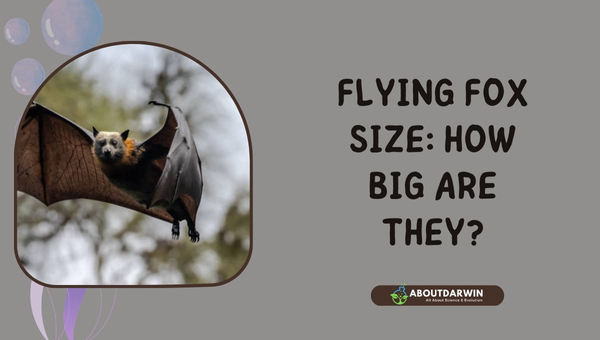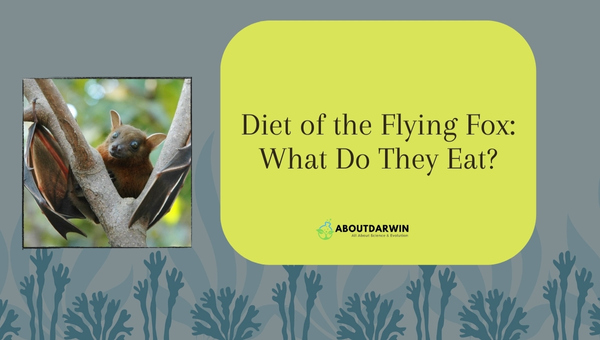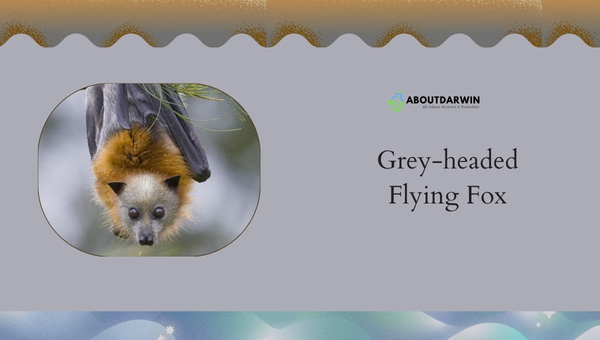Physical Address
304 North Cardinal St.
Dorchester Center, MA 02124
Flying foxes, often referred to as megabats, are remarkable creatures that captivate with their impressive size and unique adaptations. These fruit bats can boast a wingspan of up to 1.5 meters (5 feet), making them the largest bats in the world.
Their size not only aids in their ability to travel vast distances for food but also plays a vital role in their ecological contributions, such as pollination and seed dispersal.
As we explore the fascinating world of flying foxes, prepare to uncover the incredible diversity and significance of these extraordinary mammals.
Contents
Flying foxes are remarkable creatures that belong to the Pteropus genus and are known as the largest bats in the world. Their size varies significantly across species, making them fascinating subjects of study.

Let’s dive into details about their dimensions, including wingspan and body length, as well as their dietary habits.
One of the most striking features of flying foxes is their impressive wingspan. The Large Flying Fox (Pteropus vampyrus), for instance, boasts a wingspan of up to 1.5 meters (5 feet), making it one of the most awe-inspiring bats.
On the smaller end, species like the Little Golden-mantled Flying Fox (Pteropus pumilus) have wingspans ranging from 70 to 80 centimeters (27.5 to 31.5 inches).
Below is a comparison of wingspans across some common species:
| Species | Wingspan (cm) | Wingspan (inches) |
|---|---|---|
| Large Flying Fox (Pteropus vampyrus) | 130 – 150 | 51 – 59 |
| Indian Flying Fox (Pteropus giganteus) | 120 – 150 | 47 – 59 |
| Little Golden-mantled Flying Fox (Pteropus pumilus) | 70 – 80 | 27.5 – 31.5 |
Body Length Variations: The body length of flying foxes also shows significant diversity. Larger species like the Indian Flying Fox (Pteropus giganteus) can reach up to 30 centimeters (12 inches), while smaller species measure about 15 centimeters (6 inches).
Here’s a quick breakdown of their body lengths:
| Species | Body Length (cm) | Body Length (inches) |
|---|---|---|
| Large Flying Fox (Pteropus vampyrus) | 22 – 30 | 8.6 – 12 |
| Indian Flying Fox (Pteropus giganteus) | 23 – 30 | 9 – 12 |
| Little Golden-mantled Flying Fox (Pteropus pumilus) | 15 – 18 | 6 – 7 |
The Flying Foxes Diet: Beyond their size, the diet of flying foxes is another intriguing aspect. These bats are primarily frugivorous, feasting on a variety of fruits, nectar, and flowers.
The Large Flying Fox diet, for example, consists of mangoes, figs, and bananas, along with pollen and nectar, which help them sustain their energy while playing a crucial role in pollination and seed dispersal.
Understanding the flying foxes diet highlights their ecological importance in maintaining healthy forest ecosystems.
Male flying foxes are generally larger than females, a trait known as sexual dimorphism. This size difference varies among species but remains a consistent trend.
Additionally, individual variations within species mean that these size measurements serve as general guidelines rather than rigid metrics.
Exploring the world of flying foxes reveals the incredible diversity and ecological importance of these fascinating mammals, from their vast wingspans to their fruit-based diets.
Also Read: 4 Steps of the Nitrogen Cycle: Importance, Impact
When it comes to the flying fox’s diet, these fascinating creatures mainly feed on nectar, fruit, and flowers. You might be surprised to learn that they play an essential role in the environment, helping with pollination and seed dispersal.

In this section, we’ll dive into the specifics of their eating habits and preferences. Being frugivores and nectarivores, flying foxes enjoy a wide range of fruit and floral treats. Some of their favorite foods include:
Occasionally, flying foxes may supplement their diet with insects or other small creatures, but this is relatively rare.
While these mammals love feasting on fruit, keep in mind that they’re not fruit destroyers. Instead, they consume the pulp and later disperse seeds which aid in the growth of new plants.
In this way, they contribute greatly to the ecosystem and even promote plant diversity. Their diet varies among the flying fox species, but they all share a disposition towards frugivorous and nectarivorous behaviors. Let’s look at two different examples:
| Food Item | Percentage of Diet |
|---|---|
| Fruit | 70% |
| Nectar & Pollen | 30% |
| Occasionally Insects | <1% |

Typically, the Grey-headed Flying Fox munches on over 70 types of fruit, switching between seasonal offerings. Relishing in their sweet taste and leaving seeds behind helps maintain a healthy ecosystem.
| Food Item | Percentage of Diet |
|---|---|
| Fruit | 65% |
| Nectar & Pollen | 30% |
| Insects | 5% |
As for the Spectacled Flying Fox, they too enjoy a diverse range of fruit but are more likely to snack on insects as a supplemental source of nutrition. Maintaining balance in their diet is paramount to their survival.
To recap, your understanding of the flying fox’s diet should emphasize their penchant for fruit, nectar, and pollen. Remember that these gentle creatures play a vital role as pollinators and seed dispersers, benefiting the environment and ecosystems across the world.
Flying foxes, also known as fruit bats, are an intriguing species that boast some impressive qualities. Found living throughout the tropics and subtropics, these mammals prefer a specific type of living environment.
A wide distribution across the globe: Flying foxes inhabit parts of Asia, Africa, Australia, and the nearby islands. Their widespread distribution can be attributed to their ability to adapt to various environments, making them quite resilient. A few factors impact where these creatures choose to live:
Proximity to food sources: Given that flying foxes primarily feed on fruit, nectar, and flowers, they’re typically found in lush, forested areas. They may also be found in urban settings if fruit trees, such as mango or fig trees, are present. Being close to their food sources helps ensure their survival, as they can quickly and easily find nourishment.
Availability of suitable roosting sites: Roosting sites are essential for the flying fox, as they provide shelter and a place to rest. These creatures often roost in large groups, called camps or colonies, containing hundreds or even thousands of individuals.
Flying foxes typically choose roosting sites that offer protection from predators, such as dense forests or mangrove swamps. They have also been known to roost in more urban areas, favoring parks or botanical gardens.
Climate and temperature: Tropical and subtropical regions offer the ideal climate for flying foxes. They prefer warmer temperatures and high humidity, which match their preferred roosting and feeding environments. Additionally, these regions usually have abundant fruiting plants, contributing to the bats’ food supply.
To better understand their distribution, here’s a table showcasing the main species of flying fox and their corresponding geographic locations:
| Species | Geographic Location |
|---|---|
| Black Flying Fox (Pteropus Alecto) | Australia, Papua New Guinea |
| Grey-headed Flying Fox (Pteropus Poliocephalus) | Australia |
| Spectacled Flying Fox (Pteropus Conspicillatus) | Australia, Indonesia, Papua New Guinea |
| Large Flying Fox (Pteropus Vampyrus) | Southeast Asia, South Asia, Indonesia, Malaysia, Philippines |
Flying foxes thrive in habitats where they have easy access to food sources and suitable roosting sites, as well as a favorable climate. Their adaptability has allowed them to thrive across various regions, making them an important part of various ecosystems.
Flying foxes, also known as fruit bats, are fascinating creatures with unique behaviors and complex social structures. Let’s delve into the world of these nocturnal mammals to understand their lifestyle and interactions better.
Nocturnal Nature: Flying foxes are primarily active at night. They spend their days resting in trees, conserving energy for nightly foraging. Their keen sense of smell and excellent night vision helps them locate fruit, nectar, and flowers in the darkness.
Roosting Behavior: These bats prefer to roost in large colonies, which can include thousands of individuals. Roosts are typically found in trees along rivers, mangroves, or other water sources. Flying foxes display strong site fidelity, meaning they return to the same roosting site daily.
However, they may also move to new roosting sites when resources become scarce or to avoid disturbances.
Social Interactions: Flying foxes are social animals that engage in various behaviors to maintain their social structure. Some of these behaviors include:
Foraging: As mentioned earlier, flying foxes predominantly feed on fruit, nectar, and flowers. They play a crucial role in the ecosystem by acting as pollinators and seed dispersers.
They cover great distances when foraging, with some species capable of flying up to 50 kilometers (31 miles) in search of food.
| Species | Maximum Flying Distance |
|---|---|
| Pteropus vampyrus | 50 kilometers (31 miles) |
Conservation Status: Many species of flying foxes face threats from habitat loss, hunting, and climate change. Conservation efforts, such as habitat restoration and legal protections, aim to safeguard these ecologically important animals.
When it comes to the reproduction and lifespan of flying foxes, these fascinating creatures have unique reproductive habits and life cycles. Female flying foxes, also known as megabats, typically give birth to a single pup per year. Mating usually occurs from March to May, with gestation lasting around five to six months.
During the gestation period, female flying foxes form maternity camps or colonies, where they come together to give birth and raise their young. These colonies can consist of thousands of individuals, providing a safe and supportive environment for both the mothers and their offspring. Some key elements of flying fox reproduction include:
Various factors, including natural predators, disease, and human interference, influence the life expectancy of flying foxes:
Regarding their lifespan, flying foxes can live up to 15 years in the wild, while in captivity, they have been known to survive for over 20 years. However, their average lifespan is generally shorter, primarily due to the factors mentioned above.
Understanding the reproduction and life cycle of flying foxes is crucial for conservation efforts. By learning about their reproductive habits, lifespan, and challenges they face, you can better appreciate these fascinating creatures and the vital role they play in various ecosystems.
When it comes to the flying fox family, there are several common species that you may encounter. These species are known for their fascinating features and distinct behaviors. In this section, let’s take a closer look at four common species of flying foxes:
As its name suggests, the Large Flying Fox is one of the largest species of flying foxes. This megabat can have a wingspan reaching up to 6 feet (1.8 meters). These creatures primarily feed on fruits, flowers, and nectar. They are native to Southeast Asia and can be found in countries such as Malaysia, Indonesia, and the Philippines.
| Wingspan | Diet | Habitat |
|---|---|---|
| Up to 6 feet | Fruits, flowers, and nectar | Southeast Asia |
The Indian Flying Fox is another large species of flying fox, with a wingspan that can reach 4.9 feet (1.5 meters). They are native to the Indian subcontinent and can be found in countries like India, Pakistan, Bangladesh, and Nepal. Their diet is composed mostly of fruits, flowers, and nectar as well.
| Wingspan | Diet | Habitat |
|---|---|---|
| Up to 4.9 feet | Fruits, flowers, and nectar | Indian subcontinent |
Spectacled Flying Foxes are named after the distinctive light-colored fur that surrounds their eyes, giving them the appearance of wearing glasses. They have a smaller wingspan than some other species, averaging around 3.3 feet (1 meter). Native to Australia, they make their homes in tropical rainforests along the northeastern coast.
| Wingspan | Diet | Habitat |
|---|---|---|
| Up to 3.3 feet | Fruits, flowers, and nectar | Northeastern Australian coast |
The Grey-headed Flying Fox is known for its unique grey-colored head and contrasting orange fur around the neck. These megabats can have a wingspan measuring up to 3.3 feet (1 meter). They inhabit the eastern coast of Australia, and like their relatives, they feed on fruits, flowers, and nectar.
| Wingspan | Diet | Habitat |
|---|---|---|
| Up to 3.3 feet | Fruits, flowers, and nectar | Eastern Australian coast |
Each of these species of flying foxes plays a vital role in maintaining the ecosystem by acting as natural pollinators and seed dispersers. As you explore the world of flying foxes, it’s important to remember the significance these unique megabats have in preserving the health of various plant populations.
Flying foxes, also known as fruit bats, are crucial to maintaining the health and balance of our ecosystems. These remarkable creatures are not only the largest flying mammals but also play significant roles in pollination and seed dispersal.
As they feed on nectar and fruits, they facilitate the reproduction of numerous plant species, which in turn supports a diverse array of wildlife.
Despite facing threats such as habitat loss and hunting, the ecological contributions of flying foxes are invaluable for biodiversity and ecosystem resilience.
Overall, the presence of flying foxes is essential for a balanced ecosystem, highlighting the need for conservation efforts to protect these vital species.
Flying fox populations face significant threats, primarily from habitat loss due to deforestation for agriculture, logging, and urban development, which limits their roosting and feeding areas.
Hunting and persecution also contribute to their decline, as they are hunted for food, traditional medicine, or to protect fruit crops from damage.
Climate change further impacts flying foxes by disrupting food availability and breeding cycles through rising temperatures and extreme weather events like cyclones.
Conservation efforts remain inadequate, leaving these vital pollinators vulnerable despite their essential role in ecosystems.
| Species | Location | Threatened Status |
|---|---|---|
| Grey-headed flying fox | Australia | Vulnerable |
| Large flying fox | Asia | Least Concern |
| Mauritian flying fox | Mauritius | Endangered |
| Torresian flying fox | Australia | Near Threatened |
Additionally, diseases such as Hendra virus and Australian bat lyssavirus, along with invasive predators and plants, pose serious risks to their survival.
Flying foxes, also known as fruit bats, are essential for maintaining healthy ecosystems. They play a vital role in pollination and seed dispersal for many plant species. However, threats such as habitat loss, hunting, and climate change have led to declining populations in various regions. Consequently, conservation efforts are crucial to protect these remarkable creatures and maintain ecological balance.
One essential measure taken to conserve flying foxes is the establishment of protected areas. Here, the bats can find food and shelter without facing the dangers of deforestation or human encroachment. To support these conservation actions:
Another essential conservation tool is the monitoring and research of flying fox populations. This critical aspect involves:
To help support flying fox populations, responsible ecotourism is encouraged. Local economies benefit by offering opportunities for visitors to observe these fascinating mammals, raising awareness about their ecological importance. To achieve this:
Lastly, transnational collaborations are essential in coordinating conservation actions for flying fox species that migrate across national boundaries. These multinational partnerships involve:
Efforts taken to conserve flying foxes can protect these incredible creatures and contribute to the health of the ecosystems they inhabit. Your support and awareness, combined with the dedicated work of conservation organizations, governments, and local communities, can ensure the future of the flying fox and its critical environmental role.
The flying fox, a remarkable fruit bat, showcases a significant range in size that contributes to its ecological role. With wingspans varying from 70 centimeters to an impressive 1.5 meters, these “megabats” are not only the largest bats but also crucial for pollination and seed dispersal in their habitats.
Their size enables them to travel long distances in search of food, impacting the ecosystems they inhabit positively. The flying fox size enhances our appreciation for these creatures and underscores their importance in maintaining ecological balance.